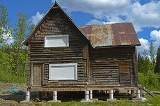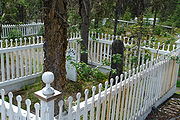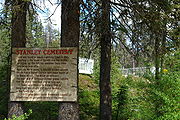
Stanley, British Columbia
Encyclopedia
Stanley was a gold rush
town in the Cariboo
region of British Columbia
that began during the Cariboo Gold Rush
.
. Stanley is located in the Cariboo
region of British Columbia
’s Central Interior. Stanley can be found by following Highway 26 east from the city of Quesnel
. A 45 minute drive along Highway 26 passes by the appropriately named Stanley Road on which the town of Stanley was located. Tourists
often pass by Stanley on their way to the historic town site of Barkerville
because of the lack of signage.
Stanley once had a sprawling population that surpassed the town of Barkerville at one time due to the gold in the area. Passing by the vicinity one would not even know that there was ever a bristling town full of gold-hungry prospectors and their families. A lone building that is now being renovated is the little visible evidence from the gravel road that there was anything ever there. But just a few steps into the now thick underbrush reveals plenty of evidence of the town of Stanley. An abundance of scrap wood, metal and remnants of buildings can be seen buried in the brush and earth.By the end of the 19th Century (1800s), Stanley had a population that surpassed the nearby town of Barkerville; Over half the population of Stanley consisted of Chinese.
The Hotel had many owners from William Ellis, John Lowe, William Morgan and Len Ford. Also super chef and confectioner Hannah Williams owned it until 1947 at the time of her death.
There is some speculation that the Hotel burned down in 1924 and was rebuilt on its original site from buildings purchased by Jimmy Williams at the defunct La Fontaine Mine.
During the early 1900s an additional wing (which was the mirror image of the original structure) was built doubling the size of the building.
It was purchased by prominent Vancouver Mining Executive Mr. Jack LaFleur and his wife Nita who opened it in 1967 for the Centennial year. After that, the building was closed and slowly fell into a state of disrepair with the second half of the building (built in the early 1900s) disappearing completely.
In 1996, Jack and Nita LaFleur's son, Mark LaFleur and his business partner Lawrence Adams took on the job of restoring the property by giving it a new foundation and securing it structurally. The work was done by Mr. Howard Berlin, the restorer of most of the buildings in Barkerville. The restoration process continues today.
 Overlooking the town of Stanley is the old Stanley Cemetery
Overlooking the town of Stanley is the old Stanley Cemetery
located atop a hill. The graveyard holds some pioneers of the gold rush area along with some later expired residents. At first glimpse, it seems as though grave robbers may have dug up some of the plots and took the bones but in truth the graves belonged to Chinese gold miners whose remains were shipped back to their birthplace.
 The old cemetery is gradually becoming a part of the land, as is the town of Stanley. The Stanley cemetery is maintained only by donation
The old cemetery is gradually becoming a part of the land, as is the town of Stanley. The Stanley cemetery is maintained only by donation
s which shows in the deterioration.
in which Stanley lies. In 2005, the Beetle kill trees were harvested around the Stanley cemetery and area for the safety of the visitors and to reduce the threat of forest fire.
In the process of logging the beetle kill trees, the fencing surrounding the Stanley cemetery and some of the individual burial plots where damaged by the fallen trees. The damaged fencing was not repaired afterwards.
In 2007, some minor restoration work was done to the area fencing.
Gold rush
A gold rush is a period of feverish migration of workers to an area that has had a dramatic discovery of gold. Major gold rushes took place in the 19th century in Australia, Brazil, Canada, South Africa, and the United States, while smaller gold rushes took place elsewhere.In the 19th and early...
town in the Cariboo
Cariboo
The Cariboo is an intermontane region of British Columbia along a plateau stretching from the Fraser Canyon to the Cariboo Mountains. The name is a reference to the woodland caribou that were once abundant in the region...
region of British Columbia
British Columbia
British Columbia is the westernmost of Canada's provinces and is known for its natural beauty, as reflected in its Latin motto, Splendor sine occasu . Its name was chosen by Queen Victoria in 1858...
that began during the Cariboo Gold Rush
Cariboo Gold Rush
The Cariboo Gold Rush was a gold rush in the Canadian province of British Columbia. Although the first gold discovery was made in 1859 at Horsefly Creek, followed by more strikes at Keithley Creek and Antler Horns lake in 1860, the actual rush did not begin until 1861, when these discoveries were...
.
History
Gold was found in nearby Lightning Creek in 1861 resulting in the towns of Stanley and Van Winkle springing up as part of the Cariboo Gold RushCariboo Gold Rush
The Cariboo Gold Rush was a gold rush in the Canadian province of British Columbia. Although the first gold discovery was made in 1859 at Horsefly Creek, followed by more strikes at Keithley Creek and Antler Horns lake in 1860, the actual rush did not begin until 1861, when these discoveries were...
. Stanley is located in the Cariboo
Cariboo
The Cariboo is an intermontane region of British Columbia along a plateau stretching from the Fraser Canyon to the Cariboo Mountains. The name is a reference to the woodland caribou that were once abundant in the region...
region of British Columbia
British Columbia
British Columbia is the westernmost of Canada's provinces and is known for its natural beauty, as reflected in its Latin motto, Splendor sine occasu . Its name was chosen by Queen Victoria in 1858...
’s Central Interior. Stanley can be found by following Highway 26 east from the city of Quesnel
Quesnel, British Columbia
-Demographics:Quesnel had a population of 9,326 people in 2006, which was a decrease of 7.1% from the 2001 census count. The median household income in 2005 for Quesnel was $54,044, which is slightly above the British Columbia provincial average of $52,709....
. A 45 minute drive along Highway 26 passes by the appropriately named Stanley Road on which the town of Stanley was located. Tourists
Tourism
Tourism is travel for recreational, leisure or business purposes. The World Tourism Organization defines tourists as people "traveling to and staying in places outside their usual environment for not more than one consecutive year for leisure, business and other purposes".Tourism has become a...
often pass by Stanley on their way to the historic town site of Barkerville
Barkerville, British Columbia
Barkerville was the main town of the Cariboo Gold Rush in British Columbia, Canada and is preserved as a historic town. It is located on the north slope of the Cariboo Plateau near the Cariboo Mountains east of Quesnel along BC Highway 26, which follows the route of the original access to...
because of the lack of signage.
Stanley once had a sprawling population that surpassed the town of Barkerville at one time due to the gold in the area. Passing by the vicinity one would not even know that there was ever a bristling town full of gold-hungry prospectors and their families. A lone building that is now being renovated is the little visible evidence from the gravel road that there was anything ever there. But just a few steps into the now thick underbrush reveals plenty of evidence of the town of Stanley. An abundance of scrap wood, metal and remnants of buildings can be seen buried in the brush and earth.By the end of the 19th Century (1800s), Stanley had a population that surpassed the nearby town of Barkerville; Over half the population of Stanley consisted of Chinese.
Last Standing Building in Stanley, The Lightning Hotel
Because of its longevity, much has been written about the Lightning Hotel from its arrival at its current site in 1873. It was originally brought down from the town of Richfield during a great fire that destroyed most of the town. The building was saved by a bucket brigade. Then moved on skids from Richfield to its present location today. The first proprietor, William Houseman, locally nicknamed The Duke of York, renamed his Yorkville Saloon to The Lightning Hotel.The Hotel had many owners from William Ellis, John Lowe, William Morgan and Len Ford. Also super chef and confectioner Hannah Williams owned it until 1947 at the time of her death.
There is some speculation that the Hotel burned down in 1924 and was rebuilt on its original site from buildings purchased by Jimmy Williams at the defunct La Fontaine Mine.
During the early 1900s an additional wing (which was the mirror image of the original structure) was built doubling the size of the building.
It was purchased by prominent Vancouver Mining Executive Mr. Jack LaFleur and his wife Nita who opened it in 1967 for the Centennial year. After that, the building was closed and slowly fell into a state of disrepair with the second half of the building (built in the early 1900s) disappearing completely.
In 1996, Jack and Nita LaFleur's son, Mark LaFleur and his business partner Lawrence Adams took on the job of restoring the property by giving it a new foundation and securing it structurally. The work was done by Mr. Howard Berlin, the restorer of most of the buildings in Barkerville. The restoration process continues today.
Stanley Cemetery

Cemetery
A cemetery is a place in which dead bodies and cremated remains are buried. The term "cemetery" implies that the land is specifically designated as a burying ground. Cemeteries in the Western world are where the final ceremonies of death are observed...
located atop a hill. The graveyard holds some pioneers of the gold rush area along with some later expired residents. At first glimpse, it seems as though grave robbers may have dug up some of the plots and took the bones but in truth the graves belonged to Chinese gold miners whose remains were shipped back to their birthplace.

Donation
A donation is a gift given by physical or legal persons, typically for charitable purposes and/or to benefit a cause. A donation may take various forms, including cash, services, new or used goods including clothing, toys, food, and vehicles...
s which shows in the deterioration.
Occupying the Stanley Cemetery
Daisy Gardner, Mearl Gardner and Mary Gardner’s first baby daughter.Mountain Pine Beetle and the Stanley Cemetery
The Cariboo region of British Columbia was ravaged by the Mountain Pine BeetleMountain pine beetle
The mountain pine beetle Dendroctonus ponderosae, is a species of bark beetle native to the forests of western North America from Mexico to central British Columbia. It has a hard black exoskeleton, and measures about 5 millimeters, about the size of a grain of rice.Mountain pine beetles inhabit...
in which Stanley lies. In 2005, the Beetle kill trees were harvested around the Stanley cemetery and area for the safety of the visitors and to reduce the threat of forest fire.
In the process of logging the beetle kill trees, the fencing surrounding the Stanley cemetery and some of the individual burial plots where damaged by the fallen trees. The damaged fencing was not repaired afterwards.
In 2007, some minor restoration work was done to the area fencing.

